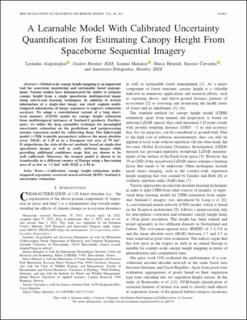| dc.contributor.author | Alagialoglou, Leonidas | |
| dc.contributor.author | Manakos, Ioannis | |
| dc.contributor.author | Heurich, Marco Dietmar | |
| dc.contributor.author | Cervenka, Jaroslav | |
| dc.contributor.author | Delopoulos, Anastasios | |
| dc.date.accessioned | 2022-11-28T14:13:04Z | |
| dc.date.available | 2022-11-28T14:13:04Z | |
| dc.date.created | 2022-09-09T14:25:39Z | |
| dc.date.issued | 2022 | |
| dc.identifier.citation | IEEE Transactions on Geoscience and Remote Sensing. 2022, 60 . | en_US |
| dc.identifier.issn | 0196-2892 | |
| dc.identifier.uri | https://hdl.handle.net/11250/3034539 | |
| dc.description | This work is licensed under a Creative Commons Attribution-NonCommercial-NoDerivatives 4.0 License. For more information, see https://creativecommons.org/licenses/by-nc-nd/4.0/. | |
| dc.description.abstract | Global-scale canopy height mapping is an important tool for ecosystem monitoring and sustainable forest management. Various studies have demonstrated the ability to estimate canopy height from a single spaceborne multispectral image using end-to-end learning techniques. In addition to texture information of a single-shot image, our study exploits multi temporal information of image sequences to improve estimation accuracy. We adopt a convolutional variant of a long short-term memory (LSTM) model for canopy height estimation from multitemporal instances of Sentinel-2 products. Furthermore, we utilize the deep ensembles technique for meaningful uncertainty estimation on the predictions and postprocessing isotonic regression model for calibrating them. Our lightweight model (∼320k trainable parameters) achieves the mean absolute error (MAE) of 1.29 m in a European test area of 79 km2. It outperforms the state-of-the-art methods based on single-shot spaceborne images as well as costly airborne images while providing additional confidence maps that are shown to be well calibrated. Moreover, the trained model is shown to be transferable in a different country of Europe using a fine-tuning area of as low as ∼2 km2 with MAE = 1.94 m. | en_US |
| dc.language.iso | eng | en_US |
| dc.rights | Attribution-NonCommercial-NoDerivatives 4.0 Internasjonal | * |
| dc.rights.uri | http://creativecommons.org/licenses/by-nc-nd/4.0/deed.no | * |
| dc.subject | Calibration | en_US |
| dc.subject | canopy height estimation | en_US |
| dc.subject | multi temporal regression | en_US |
| dc.subject | recurrent neural network (RNN) | en_US |
| dc.subject | Sentinel-2 | en_US |
| dc.subject | uncertainty estimation. | en_US |
| dc.title | A Learnable Model with Calibrated Uncertainty Quantification for Estimating Canopy Height from Spaceborne Sequential Imagery | en_US |
| dc.title.alternative | A Learnable Model with Calibrated Uncertainty Quantification for Estimating Canopy Height from Spaceborne Sequential Imagery | en_US |
| dc.type | Peer reviewed | en_US |
| dc.type | Journal article | en_US |
| dc.description.version | publishedVersion | en_US |
| dc.subject.nsi | VDP::Matematikk og Naturvitenskap: 400 | en_US |
| dc.source.pagenumber | 0 | en_US |
| dc.source.volume | 60 | en_US |
| dc.source.journal | IEEE Transactions on Geoscience and Remote Sensing | en_US |
| dc.identifier.doi | 10.1109/TGRS.2022.3171407 | |
| dc.identifier.cristin | 2050350 | |
| cristin.ispublished | true | |
| cristin.fulltext | original | |
| cristin.qualitycode | 2 | |

